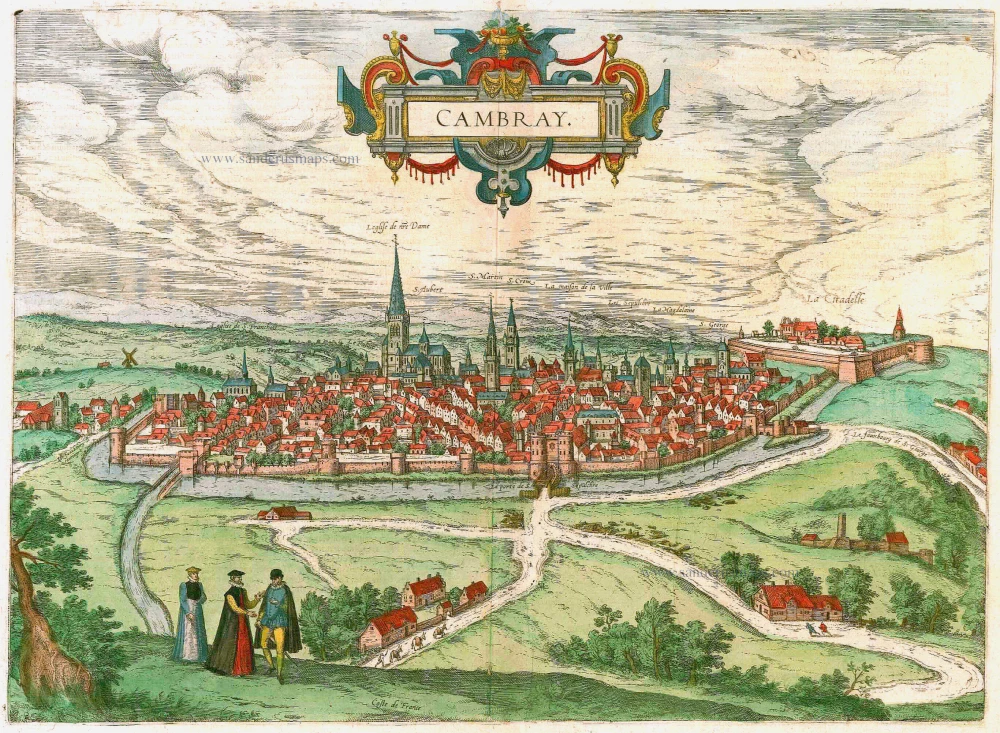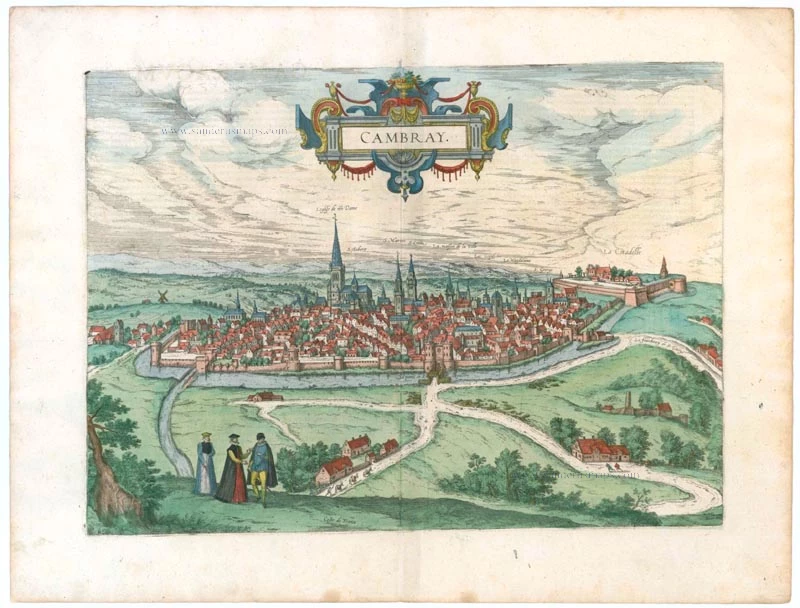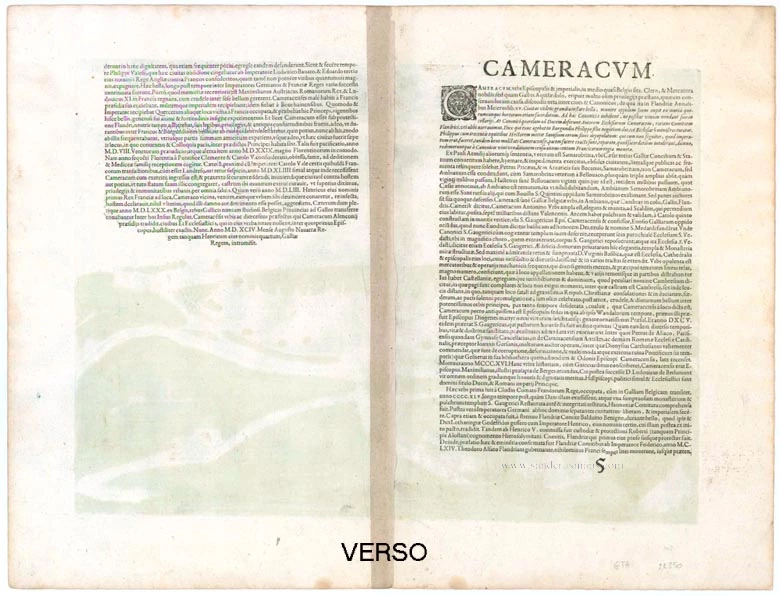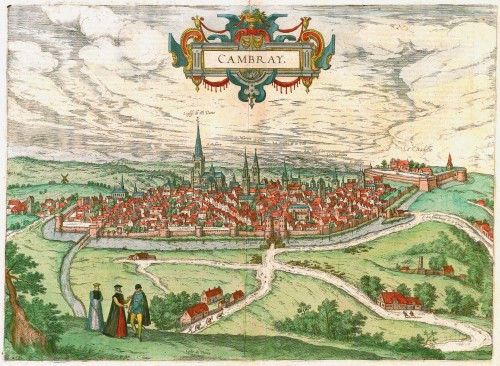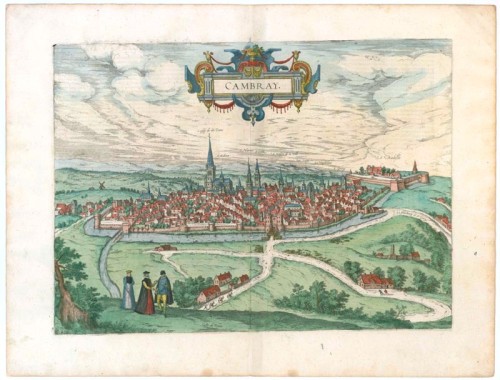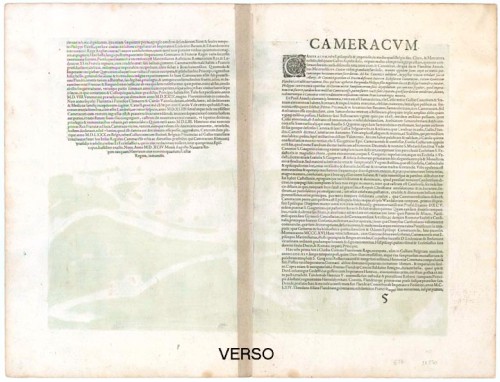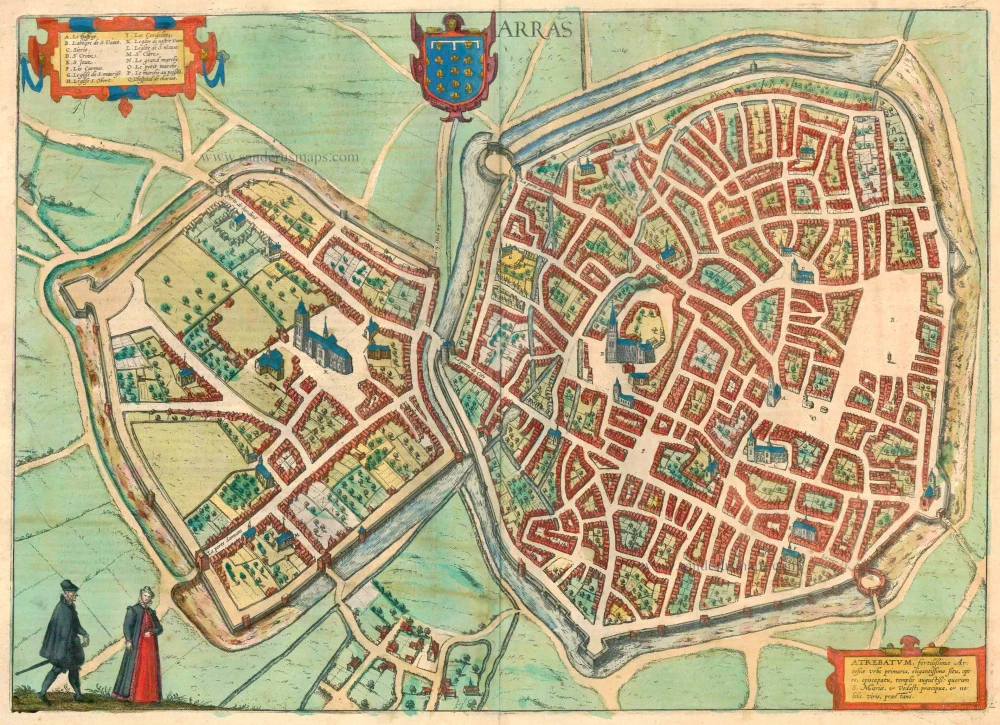Cambrai by Braun & Hogenberg. 1588-97
COMMENTARY BY BRAUN: "Cambrai is a broad, very handsome and well fortified town on the Schelde, which flows through it. It has a splendid fortified castle built by Charles V on the top of a hill. St Gaugericus, the bishop of Cambrai, had a magnificent church built there in honour of St Medardus. The town houses are most handsome, but the churches and monasteries are even more splendid. Rising above them is the old church of Our Lady, which is also the bishop's seat."
Cambrai was granted a municipal charter in 1076. It is presented here in cavalier perspective from the top of an imaginary hill. The detailed depiction of the fortifications, originally built by Charlemagne around AD 800, and of the churches, especially the Gothic cathedral of Notre-Dame-de-Grâce, testifies to a high degree of topographical reliability. The town hall (La maison de ville) can also be clearly discerned. From 1550 the tower of the church of Saint Martin was the belfry of Cambrai, and still serves as such today. The church of the abbey of Saint-Aubert, today the church of Saint-Géry, goes back to the remains of a 6th-century ecclesiastical building. In the 16th century Cambrai was the scene of some important historical events: in 1508 the League of Cambrai was founded here, in which Louis XII of France, the holy Roman Emperor Maximilian I, Ferdinand II of Spain and Pope Julius II formed an alliance to curb the Republic of Venice's influence in northern Italy. It was here, in 1529, that Francis I of France and Emperor Charles V signed the Treaty of Cambrai, also known as the Paix des Dames. (Taschen)
Braun G. & Hogenberg F. and the Civitates Orbis Terrarum.
The Civitates Orbis Terrarum, also known as the 'Braun & Hogenberg', is a six-volume town atlas and the most excellent book of town views and plans ever published: 363 engravings, sometimes beautifully coloured. It was one of the best-selling works in the last quarter of the 16th century. Georg Braun, a skilled writer, wrote the text accompanying the plans and views on the verso. Many plates were engraved after the original drawings of a professional artist, Joris Hoefnagel (1542-1600). The first volume was published in Latin in 1572 and the sixth in 1617. Frans Hogenberg, a talented engraver, created the tables for volumes I through IV, and Simon van den Neuwel made those for volumes V and VI. Other contributors were cartographers Daniel Freese and Heinrich Rantzau, who provided valuable geographical information. Works by Jacob van Deventer, Sebastian Münster, and Johannes Stumpf were also used as references. Translations appeared in German and French, making the atlas accessible to a broader audience.
Since its original publication of volume 1 in 1572, the Civitates Orbis Terrarum has left an indelible mark on the history of cartography. Seven more editions followed the first volume in 1575, 1577, 1582, 1588, 1593, 1599, and 1612. Vol.2, initially released in 1575, saw subsequent editions in 1597 and 1612. The subsequent volumes, each a treasure trove of historical insights, graced the world in 1581, 1588, 1593, 1599, and 1606. The German translation of the first volume, a testament to its widespread appeal, debuted in 1574, followed by the French edition in 1575.
Several printers were involved: Theodor Graminaeus, Heinrich von Aich, Gottfried von Kempen, Johannis Sinniger, Bertram Buchholtz, and Peter von Brachel, all of whom worked in Cologne.
Georg Braun (1541-1622)
Georg Braun, the author of the text accompanying the plans and views in the Civitates Orbis Terrarum, was born in Cologne in 1541. After his studies in Cologne, he entered the Jesuit Order as a novice, indicating his commitment to learning and intellectual pursuits. In 1561, he obtained his bachelor's degree; in 1562, he received his Magister Artium, further demonstrating his academic achievements. Although he left the Jesuit Order, he continued his studies in theology, gaining a licentiate in theology. His theological background likely influenced the content and tone of the text in the Civitates Orbis Terrarum, adding a unique perspective to the work.
Frans Hogenberg (1535-1590)
Frans Hogenberg was a Flemish and German painter, engraver, and mapmaker. He was born in Mechelen as the son of Nicolaas Hogenberg.
By the end of the 1560s, Frans Hogenberg was employed upon Abraham Ortelius's Theatrum Orbis Terrarum, published in 1570; he is named an engraver of numerous maps. In 1568, he was banned from Antwerp by the Duke of Alva and travelled to London, where he stayed a few years before emigrating to Cologne. He immediately embarked on his two most important works, the Civitates, published in 1572 and the Geschichtsblätter, which appeared in several series from 1569 until about 1587.
Thanks to large-scale projects like the Geschichtsblätter and the Civitates, Hogenberg's social circumstances improved with each passing year. He died as a wealthy man in Cologne in 1590.
Cambray
Item Number: 10781 Authenticity Guarantee
Category: Antique maps > Europe > France - Cities
Antique map of Cambrai by Braun & Hogenberg.
Title: Cambray.
Date: 1588-97.
Copper engraving, printed on paper.
Size (not including margins): 330 x 453mm (12.99 x 17.83 inches).
Verso: Latin text.
Condition: Original coloured, excellent.
Condition Rating: A+.
From: Liber quartus Urbium Praecipuarum totius Mundi. Cologne, 1588-97. (Koeman, B&H4, Van der Krogt 4, 41:1.4)
COMMENTARY BY BRAUN: "Cambrai is a broad, very handsome and well fortified town on the Schelde, which flows through it. It has a splendid fortified castle built by Charles V on the top of a hill. St Gaugericus, the bishop of Cambrai, had a magnificent church built there in honour of St Medardus. The town houses are most handsome, but the churches and monasteries are even more splendid. Rising above them is the old church of Our Lady, which is also the bishop's seat."
Cambrai was granted a municipal charter in 1076. It is presented here in cavalier perspective from the top of an imaginary hill. The detailed depiction of the fortifications, originally built by Charlemagne around AD 800, and of the churches, especially the Gothic cathedral of Notre-Dame-de-Grâce, testifies to a high degree of topographical reliability. The town hall (La maison de ville) can also be clearly discerned. From 1550 the tower of the church of Saint Martin was the belfry of Cambrai, and still serves as such today. The church of the abbey of Saint-Aubert, today the church of Saint-Géry, goes back to the remains of a 6th-century ecclesiastical building. In the 16th century Cambrai was the scene of some important historical events: in 1508 the League of Cambrai was founded here, in which Louis XII of France, the holy Roman Emperor Maximilian I, Ferdinand II of Spain and Pope Julius II formed an alliance to curb the Republic of Venice's influence in northern Italy. It was here, in 1529, that Francis I of France and Emperor Charles V signed the Treaty of Cambrai, also known as the Paix des Dames. (Taschen)
Braun G. & Hogenberg F. and the Civitates Orbis Terrarum.
The Civitates Orbis Terrarum, also known as the 'Braun & Hogenberg', is a six-volume town atlas and the most excellent book of town views and plans ever published: 363 engravings, sometimes beautifully coloured. It was one of the best-selling works in the last quarter of the 16th century. Georg Braun, a skilled writer, wrote the text accompanying the plans and views on the verso. Many plates were engraved after the original drawings of a professional artist, Joris Hoefnagel (1542-1600). The first volume was published in Latin in 1572 and the sixth in 1617. Frans Hogenberg, a talented engraver, created the tables for volumes I through IV, and Simon van den Neuwel made those for volumes V and VI. Other contributors were cartographers Daniel Freese and Heinrich Rantzau, who provided valuable geographical information. Works by Jacob van Deventer, Sebastian Münster, and Johannes Stumpf were also used as references. Translations appeared in German and French, making the atlas accessible to a broader audience.
Since its original publication of volume 1 in 1572, the Civitates Orbis Terrarum has left an indelible mark on the history of cartography. Seven more editions followed the first volume in 1575, 1577, 1582, 1588, 1593, 1599, and 1612. Vol.2, initially released in 1575, saw subsequent editions in 1597 and 1612. The subsequent volumes, each a treasure trove of historical insights, graced the world in 1581, 1588, 1593, 1599, and 1606. The German translation of the first volume, a testament to its widespread appeal, debuted in 1574, followed by the French edition in 1575.
Several printers were involved: Theodor Graminaeus, Heinrich von Aich, Gottfried von Kempen, Johannis Sinniger, Bertram Buchholtz, and Peter von Brachel, all of whom worked in Cologne.
Georg Braun (1541-1622)
Georg Braun, the author of the text accompanying the plans and views in the Civitates Orbis Terrarum, was born in Cologne in 1541. After his studies in Cologne, he entered the Jesuit Order as a novice, indicating his commitment to learning and intellectual pursuits. In 1561, he obtained his bachelor's degree; in 1562, he received his Magister Artium, further demonstrating his academic achievements. Although he left the Jesuit Order, he continued his studies in theology, gaining a licentiate in theology. His theological background likely influenced the content and tone of the text in the Civitates Orbis Terrarum, adding a unique perspective to the work.
Frans Hogenberg (1535-1590)
Frans Hogenberg was a Flemish and German painter, engraver, and mapmaker. He was born in Mechelen as the son of Nicolaas Hogenberg.
By the end of the 1560s, Frans Hogenberg was employed upon Abraham Ortelius's Theatrum Orbis Terrarum, published in 1570; he is named an engraver of numerous maps. In 1568, he was banned from Antwerp by the Duke of Alva and travelled to London, where he stayed a few years before emigrating to Cologne. He immediately embarked on his two most important works, the Civitates, published in 1572 and the Geschichtsblätter, which appeared in several series from 1569 until about 1587.
Thanks to large-scale projects like the Geschichtsblätter and the Civitates, Hogenberg's social circumstances improved with each passing year. He died as a wealthy man in Cologne in 1590.

